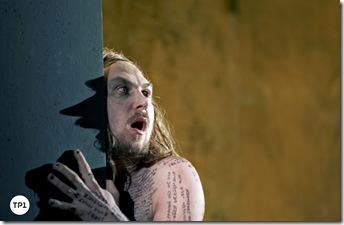Updating Tartuffe at the FTA
Photo: Katrin Ribbe. Lars Eidinger as Tartuffe
Tartuffe was one of the most anticipated productions of the 2015 Festival TransAmériques in Montréal. Produced by Berlin’s cutting-edge Schaubüne Theatre under the direction of Tomas Ostermeier, known for his revisions of classical works, it is safe to say that (in most respects) this is a Tartuffe unlike any other. Knowledge of Molière’s play is needed to follow this often confusing adaptation. The confusion stems more from the director’s realization of his concept than the translated script whose few changes are congruous with the ideas presented.
Although Olaf Altmann’s high and box-like set is a modernist version of the picture frame stage, the production is not ruled by time. A contemporary black leather armchair, center stage, is the only furniture used; the walls are of mottled gold (filthy lucre?). A small black crucifix is centered on the back wall.
The actors’ costumes represent various eras. Reviving an old tradition, Michael Thalheimer has Madame Pernelle played in drag. A balding Felix Römer wears a long black dress with a tight-fitting bodice and seventeenth-century ruff.
Tartuffe (Lars Eidinger), here a young man garbed in gray pants and a shirt, has an almost cliché biblical appearance with his blond beard and long-haired wig. He is at once reminiscent of medieval and renaissance paintings of Jesus and of Andrew Lloyd Weber’s rock musical, Jesus Christ Superstar, but without the clean-cut look. Tartuffe removes his shirt revealing a body tattooed in scripture.
The maid Dorine (Cathlen Gawlich) is confidently chic in her black outfit. Damis (Franz Hartwig), the presumed heir to Orgon’s fortune, is attired in shorts, white shirt, red pullover, and knee socks, like a child of the 1940s. Marianne (Luise Wolfram) wears a blue dress, white sweater, and yellow knee socks, while her sweetheart Valère (Tilman Strauss) evokes the 1970s in his bright print shirt. In contrast to their modern clothing most of the men wear wigs similar to Tartuffe’s. At various points, they remove the hair pieces and then replace them. The significance escaped me.
The movement-dependent acting is highly stylized with the performers playing straight out to the audience for the most part rather than to each other. Inner feelings are physicalized, often in an exaggerated manner. Marianne walks and gestures as if palsied. Are these uncontrolled tremors the result of her fear of her father Orgon or of her sexual longings? Damis spends much of his time onstage kneeling with his head down, his bottom in the air. Valère frequently clutches his crotch. Urs Jucker’s Monsieur Loyal, played for laughs, stretches out his scene with shtick that involves twitches and tics.
Unlike Molière’s Tartuffe, a religious hypocrite, the Schaubüne’s Tartuffe is a believer, yet I found him even more unlikable than Molière’s Tartuffe. His angry religious exhortation at the beginning of the play in which he predicts future horrors and inveighs against the rich is delivered in a Hitlerian tone. He destroys Orgon and his family, leaving them destitute, while he winds up with all their possessions. An ironic situation for someone who claims to despise the wealthy. However, the production indicates divinity. Towards the close of the play, for example, he stands with his arms outstretched and begins his speech with Jesus’ words on the cross, “My God, why hast thou forsaken me?” What are we to make of this?
Eidinger and Thalheimer conceived Tartuffe as a contemporary rock star brimming over with sex appeal. Most of the characters are very attracted to him, running their hands over his body hungrily as he ignores them. At the same time, this “saintly” figure seems even more lecherous than Molière’s Tartuffe in his coarse attempts to seduce Dorine and Elmire, both of whom reject him.
One of the more striking elements of the production is the vertical revolving set, which is used symbolically to denote changes in status. Rather than hiding under a table to spy on Tartuffe, Orgon remains in his chair. When he realizes what is happening, the set tilts and Orgon finds himself on the wall, still in his chair. The family screams in fear; the cross falls on its side, and everyone slides to the bottom. Tartuffe leaves.
Although the production’s ideas were not consistently and thoroughly worked through, I thought it an interesting experiment. The audience was very responsive, on their feet at the finish applauding.
Produced By ………….. Schaubuhne
Original Text ………….. Molière
German Translator ……. Wolfgang Wiens
Director ……………….. Michael Thalheimer
Set Designer ………….. Olaf Altmann
Costume Designer …… Nehle Balkausen
Lighting Designer ……. Bert Wrede
English Translator ……. Neil Kroetsch
French Translator …….. Bettina Vogt
Cast
Tartuffe ………. Lars Eidinger
Dorine …………Cathlen Gawlich
Damis ………… Franz Hartwig
Orgon …………. Ingo Hülsmann
Monsieur Loyal .. Urs Jucker
Elmire …………. Eva Meckbach
Madame Pernelle .Felix Römer
Cléante ………… Kay Bartholomaüs Schulze
Valère ………….. Tilman Strauss
Mariane ………… Luise Wolfram
